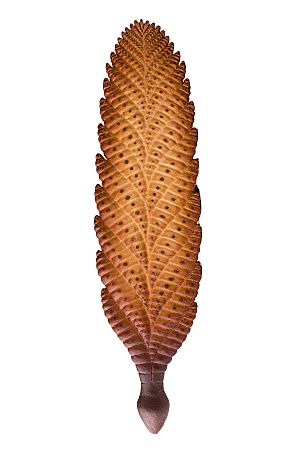Charnia facts for kids
Charnia is the name of a very old, fern-like creature. It lived a long, long time ago, during a period called the Ediacaran. Charnia had a main stem with branches coming off it, like a plant. Scientists named it after Charnwood Forest in Leicestershire, England. This is where the very first fossil of Charnia was discovered.
Contents
Why Charnia is Important
Charnia is a super important fossil! Here's why:
- It was the first fossil found in Precambrian rocks. Before this, people thought there were no fossils from that time.
- Other similar fossils were found earlier. But scientists thought they were from a later time, the Cambrian period.
- Charnia became a famous example of early animals.
- At first, scientists thought it was a type of algae.
- Later, they thought it was like a "sea pen". Sea pens are related to modern soft corals.
- Now, scientists are not sure what it is. It's still a bit of a mystery!
How Charnia Lived
We don't know much about how Charnia lived.
- It stayed on the sea floor. It was anchored there, like a plant.
- It probably lived in very deep water. This means sunlight could not reach it.
- So, it could not make its own food using sunlight, like plants do (photosynthesis).
- Charnia also didn't have a mouth or a gut. This makes its lifestyle a puzzle.
- Some scientists think it might have filtered tiny bits of food from the water.
- Others think it absorbed nutrients directly from the water.
Scientists also studied how Charnia grew. It grew new parts from its top. This is different from sea pens, which grow new parts from their bottom. This difference helped scientists realize Charnia was not a sea pen.
Where Charnia Fossils Are Found
Charnia is the most widespread Ediacaran fossil. It has been found in many places and times. The oldest and most common Charnia fossils are in Mistaken Point Ecological Reserve in Newfoundland.
Different Types of Charnia

There are three main types, or species, of Charnia: C. masoni, C. wardi, and C. antecedens. They look a bit different in their length, width, and how their branches connect.
- Charnia masoni: This species was found in 1957 by Roger Mason. He was a schoolboy at the time! A year before, a 15-year-old schoolgirl named Tina Negus saw this fossil. But her teacher said it couldn't be a fossil from the Precambrian.
- Charnia wardi: This type was found in 1978 in Newfoundland. It was described in 2003. It is the longest-lasting Ediacaran fossil, surviving for over 2 million years. It is long and narrow.
- Charnia antecedens: This species has branches that are more uneven and at higher angles than C. masoni.
Scientists think some other Ediacaran fossils might just be Charnia that has decayed in different ways.
Images for kids
-
Charnia masoni index fossil, Leicester Museum & Art Gallery, Leicester
See also
 In Spanish: Charnia para niños
In Spanish: Charnia para niños



